Nothing new there, it's how groups like US Right To Know and their parent, Organic Consumers Association, earn money from their clients. But the paper even made its way into a real article in a real paper in Australia, and since I was giving a private class for scientists who want to do outreach this week I used the article to show how journalists who don't understand science as well as scientists can be duped by an aggressive press release (from the University of Melbourne) and a corresponding author willing to sound truth-y, aided and abetted by a crash course at Google University. The journalist, Liam Mannix, is from Australia (Sydney Morning Herald) and I had never read his work before so it was easy to be more objective, even though it was on a topic that I have been writing on for years and so might be a psychological hot button. (1)
I did what I could to write my talk into an article, and I apologize in advance for my inability to be brief. Pictures tell a thousand words but in a class you use both and I did.
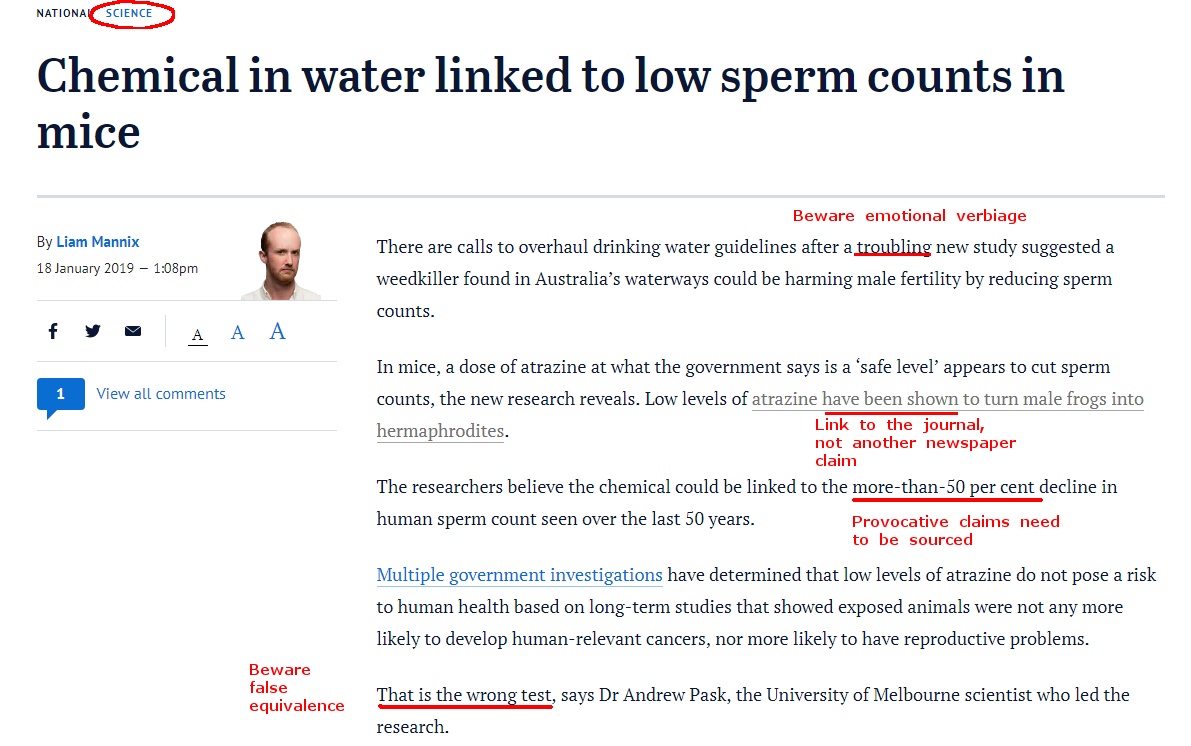
The title is good, it notes this is only a mouse study, though scientists wonder why a mouse study is getting press at all. The first sentence tells us why it got published; editors like "sexy" provocative claims, and therefore journalists who want to stay employed do also. Provocative claims are also a good way to attract eyeballs, and get lots of Twitter retweets.
But this is about good science journalism, not appeals to social media activists. And in good journalism emotional verbiage is frowned upon. A science journalism article has different standards than an op-ed. My op-eds here can be downright bombastic, but when I write for Wall Street Journal, Wired, USA Today, etc. the tone is different. Less emotional and more factual. (2)
Emotional verbiage is a pitfall that will take your article out of believability and it is never "troubling" that a study in mice found anything at all, it's common. In mice, cancer has been cured 10,000 times. So has Parkinson's, Alzheimer's and autism. There is a reason that no product can ever come to market based on mouse studies alone - even poison for mice - and that is because rodent models can only eliminate links between cause and effect, they can never show them.
That said, if the goal is to move the political needle rather than write a journalism article, it's a solid technique.
Mice studies, like epidemiology food frequency questionnaires, should be forced to have EXPLORATORY watermarked in giant red print across the pages. If this paper had, the word "troubling" would never have been used (3), unless the editor was making a conscious decision to take a cultural stand rather than publish journalism.
Other newspaper articles are not sources in science journalism
This usually goes without saying but it happens here. Instead of linking to the paper he references, the journalist links to a 2002 newspaper article about the PNAS study and some editorializing by Berkeley Professor Tyrone Hayes, who led the 2002 study. His claims were promoted heavily by Pesticide Action Network and other groups aided by trial lawyers, but the PNAS paper itself has been discredited. Professor Hayes did say frogs became hermaphrodites, and it got national attention, but he never showed it. EPA even convened a special panel based on his paper but when they asked him for his data, actual proof of his claims, he refused to provide any, and it turned out no one at PNAS ever saw it either.
Worse, it was later revealed that his paper was hand-walked past peer review by a member of the Academy, Dr. David Wake, that printed the journal, a personal friend of Hayes and whose wife was Dean of the department. Under "gentleman's rules" that existed in PNAS at the time, members could hand-select papers to do peer review for their friends.
After I exposed this travesty against science in the Wall Street Journal PNAS changed that policy so it is no longer allowed.
If it sounds too good to be true, in a 'why isn't this banned? way, it's too good to be true
It all screamed conflict of interest, but in 2002 that was not yet known. That is why you don't use 16 year-old newspaper articles as sources. Now it is known that the experiments by Hayes have never been replicated or reproduced, including by groups who really wanted to legitimize him. His methodology remains a mystery. Given his inexperience at the time it was likely statistical error and he didn't want it exposed so he simply ignored EPA's requests for data. Today, his whole career involves being flown on junkets by environmental groups to tell elementary school kids to be afraid of chemicals (rich white elites send him to Africa to preach against science as well), so he'll never admit he was wrong.
Should journalists be able to know all that?
Well, yes. It's been over 16 years since his claim, which means it's been 13 years since EPA found no proof. A quick Google search shows this information is all readily available.
Beware false equivalence
It is commonplace for journalists to use both sides of a story, because newspapers are heavy on politics, and in politics there is one side, then the other side, and then the truth. Science is often easier because there is fact on one side and the rest is speculation. By showcasing someone who says he has overturned every reputable science body using a mouse study, a journalist will look gullible. Would a sentence that reads "Multiple government agencies have determined climate change is happening" then be followed by some guy who says temperature is the wrong measurement? Most journalists know not do that, but when it comes to food, chemicals, and medicine, it is very common for writers to quote Environmental Working Group or Center for Biological Diversity or Center for Science in the Public Interest against science, even though they are lawyers and not scientists.
When you engage in false equivalence, scientists look at you like this:
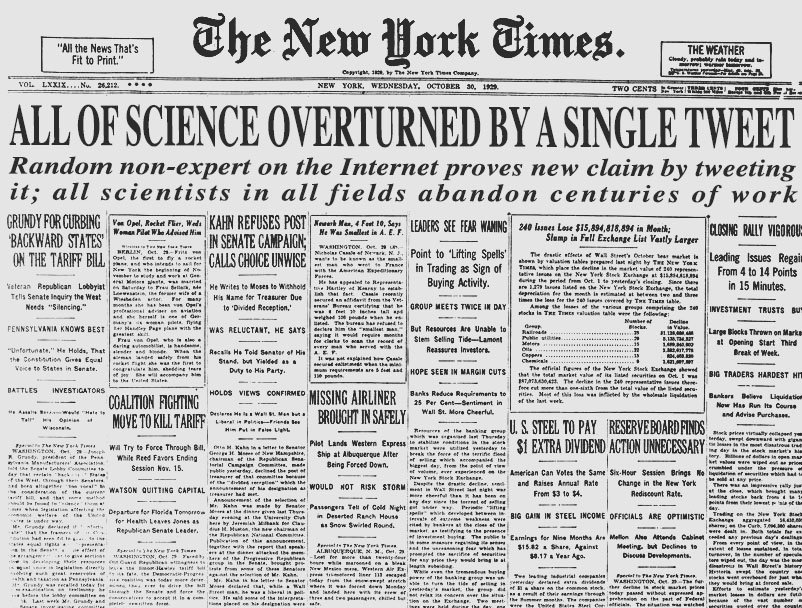
A provocative claim in a low impact journal should be viewed with skepticism
Reproduction, Fertility and Development sounds legitimate, but there are 50,000 journals now, and all of them have authoritative sounding names. Open access has been incredibly valuable in allowing taxpayers to read the results they fund, but as we cautioned when the movement was nascent, it led to a rash of suspect publications where you can literally pay to get anything published. This journal is instead one of the numerous imprints pushed out by a tiny organization that will charge you $25 to read an article, like this one, because its existence is "dependent on the capacity to generate revenue and sufficient return on investment" for its parent, Australia's Commonwealth Scientific and Industrial Research Organisation (CSIRO.)
They need profits. They need media attention, they need impact factor, they need advertisers. In other words, they are in business just like the company that makes the weedkiller that the mouse study is criticizing.
So don't be duped by a provocative claim by a journal or a university any more than you would a company press release.
The word "chemical" itself is scary to much of the public so it is low-hanging fruit for journals and journalists, but exploiting that reality that does not make it good journalism. They will object to that simple framing, as they should, but it is hypocritical when they are engaging in just that kind of framing to generate media buzz.
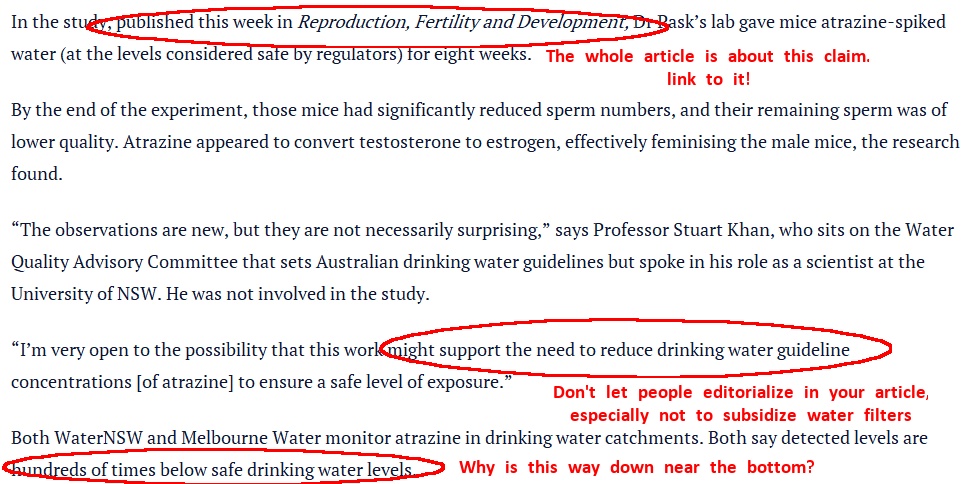
Be accurate about the people you quote - otherwise you undermine yourself and them
Stuart Khan is not a scientist nor does he claim to be one in his bio below so he should not be called one in the article, and his personal beliefs should not be used to suggest we should overturn 100,000 scientists, like all of the biologists and toxicologists who know that magic does not exist, Paracelsus is still right, trace levels of a compound cannot cause harm if high levels cannot, and therefore this study can't be legitimate.

A scientist would have stated that since the water is already safe - by orders of magnitude - sticking taxpayers with the bill for filters that will help no one is a waste of money, but another study to replicate this provocative finding might be warranted. Instead we got uninformed agreement without regard for the cost. Most likely a lawyer somewhere has told a whole lot of environmental academics they will stick an evil corporation with the bill (minus 40 percent for legal fees, of course) so they are just calling for precautionary principle spending despite evidence it will do anything. It doesn't work that way. Consumers always pay, and poor people pay most of all.
"Subtle effects" is codeword for homeopathy - don't get lumped in with that kind of journalist
Dr. Pask, quoted in the article, and colleagues gave mice low doses of water with the weedkiller atrazine and observed sperm differences. Okay, that is a talking point, and he is on shaky ground because mice fed normal chow also show wide differences in sperm from week to week, but then he says he is critical that regulatory agencies and scientists use "high doses" until they find a No-Observed-Effect level (NOEL) - where no changes are detected - and then set water standards well below that. He's correct, that is what regulatory agencies have done with the product he opposes, atrazine, the numerous times it has been re-approved.
Why is he critical of that? That is science. You don't run around claiming there are undetectable effects at trace levels despite any evidence, that is voodoo.
He suggests that instead of natural laws, where biology and chemistry work in the known universe, there is a U-shaped curve for atrazine in water in mice, where very high levels can be harmful and very low levels can be harmful, but nothing happens in between.
So a single molecule of Chemical X in a glass of water can harm you but normal amounts do nothing? It sounds like any child who has run a lemonade stand knows more chemistry than this biologist.
Does 'more dilution leads to greater biological impact' sound familiar? It does to scientists. That's homeopathy - a belief that trace levels of compounds diluted beyond recognition in water create magic.
Don't feed the trolls - you will be overrun with trade group claims and be on a "reliable" list of advocates like Tom Philpott, Naomi Oreskes, and Joe Mercola
This Homeopathy of Chemicals thinking is very popular in the US also. Fred Vom Saal, Pete Myers, and lots of other anti-science groups have been promoting that narrative since the 1990s.
Environmental Homeopathy may never go away, some people still believe in Alternative Medicine Homeopathy 200 years after it was debunked. But it looks as bad for a science article to promote it just like it would be bad to claim that low levels of CO2 will be just as bad as high levels; Atmospheric Homeopathy. Let's ban greenhouses!
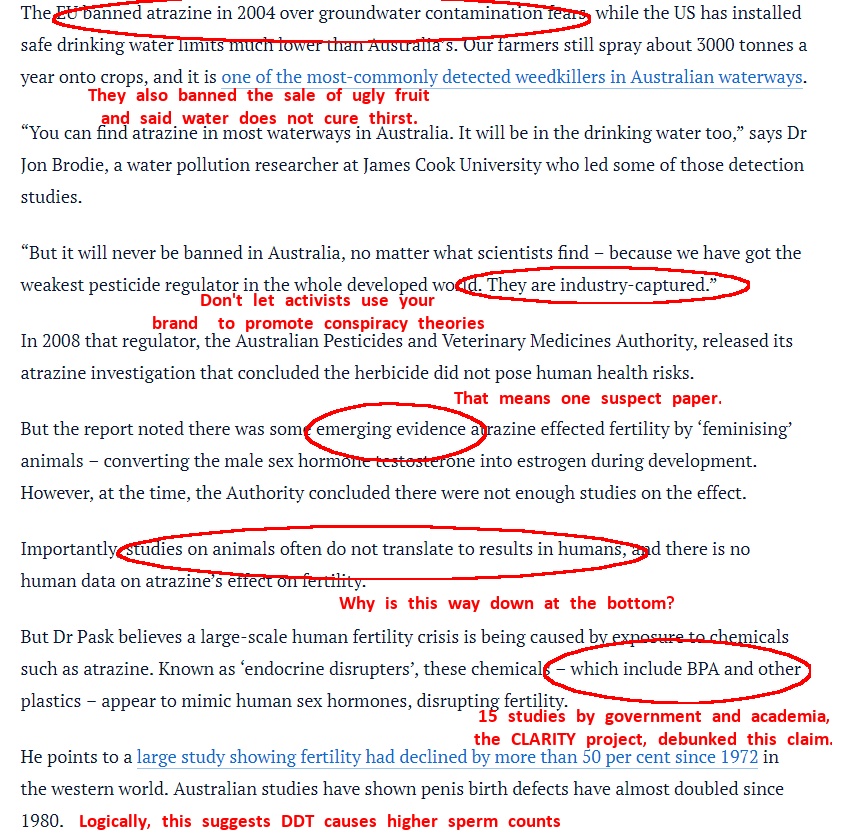
And it looks weasel-y for a journalist to throw unproven conspiracy theory like that into an article, because we know they will then fall back on the "it's not me, I'm just the journalist" rationalization even though they sought out the source. Maybe the article was assigned, or maybe it was pitched, but an editor approved it either way. And anyone literate enough to do so should know to ask awkward questions about chemical claims the same way they would about an article promoting a paper saying lower levels of CO2 will increase climate change.
If this U-shaped curve, and claims that trace levels of chemicals are "endocrine disruptors", ever gets proven, it will then be real science. Until then, it remains alternative science. It is the toxicological and biological equivalent of acupuncture.
Honestly, if your study finds extremely low doses "seem to have the greatest effect on fertility", your methodology was junk and you screwed up. The only reason it got published is because a vanity imprint of CSIRO needed content, or it did not go through peer review. There is no gentle way to put it.
And experienced journalists should know to avoid giving rubbish attention.
University PIOs are not part of the solution if they are creating the problem, you have to be the filter
But in fairness this was still a journalism article, and so nothing like the true paranoid advocacy trainwreck produced by the University of Melbourne itself to get the article written. If you are in a hard science, be prepared to get pig blood thrown at you if this is the kind of gibberish about chemistry they routinely write.
There isn't a word of scientific truth in any of this, it is all hyperbole, speculation. and overt manipulation.
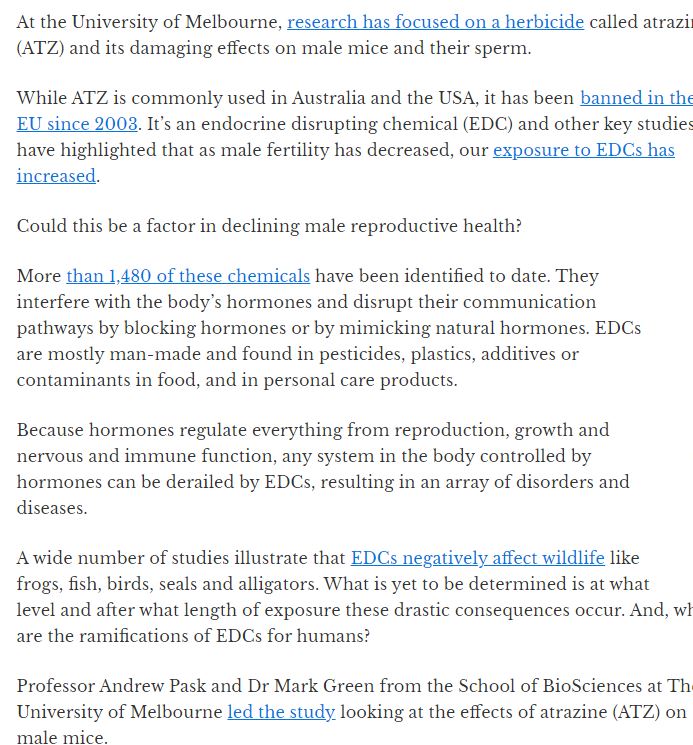
This chemophobia fever dream by Nerissa Hannink, Ph.D. doesn't deserve a serious response. Moon landing hoax people come across as more balanced than this. But because it is so outrageously biased against science, and meets the 'too good to be true' metric gullible people love to believe is true, it was reprinted even as far away as Slovakia.
That's exactly what the authors set out to accomplish when they designed their study. And that is evidence they regard science as some kind of hustle, and not a public good.
Science journalism can protect against that also.
NOTES:
(1) If it was Danny Hakim / Eric Lipton / Sheila Kaplan of the New York Times in the U.S. I couldn't be objective, because they are political writers dabbling in science when it matches their goal - manufacturing conspiracy theories, chemicals are killing us, etc. Science media knows they lift pieces verbatim from trial lawyers (EWG, CSPI) and organic trade groups paid to undermine scientists.
(2) We can blame Hunter Thompson for why many in modern journalism need to editorialize newspaper articles. But if you read his real journalism, like sports, he was fantastic. He knew rules and so it made sense when he broke them. By "Fear and Loathing in Las Vegas" he was writing “The press is a gang of cruel fagg--s. Journalism is not a profession or a trade. It is a cheap catch-all for fuc--ffs and misfits—a false doorway to the backside of life, a filthy piss-ridden little hole nailed off by the building inspector, but just deep enough for a wino to curl up from the sidewalk and masturbate like a chimp in a zoo-cage.” Too many journalists now jump right to that without ever learning the critical thinking that begat it.
While it's fun to imagine him chain-smoking red Dunhills as his IBM Selectric is blasting everyone in sight, his Gonzo Journalism ruined a whole lot of journalists who wanted to mimic him, the way Woodward and Bernstein ruined journalism for the next generation by using anonymous sources and getting a movie made about them. And the way activists who went into soft sciences "to make a difference" in their pet political causes, like banning pesticides, ruin trust in all science by the public.
(3) When Science 2.0 began, within the first six months I believed NASA was close to finding life on another planet, cancer had been cured, and that both red wine and chocolate would lead to increased longevity. You eventually learn government agencies and universities are selling you something no different than a corporation is. It's just not done with direct advertising.




Comments